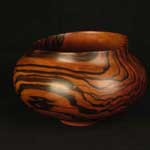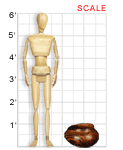VAM galleries including this work:
Kentucky Museum of Art and Craft | What’s the Point? | Art Through Time || VAM Home
Rude Osolnik (1915-2001)
MACASSAR EBONY BOWL, 1990
Turned wood; 12" X 8"
Kentucky Museum of Art and Craft
This beautiful turned bowl was crafted by master woodturner Rude Osolnik. It is made of Macassar ebony, a very dense and heavy wood that typically has alternating bands of light and dark, creating a striped appearance. Macassar ebony has been used for hundreds of years in the construction of furniture and various musical instruments (such as the dark keys on pianos). Ebony can be difficult to work with, as it is very hard and often brittle. This piece was turned on a piece of machinery called a lathe.
As this bowl exemplifies, Osolnik was known for creating beautiful pieces from solid blocks of exotic, aged woods with unusual markings and grains. He was also concerned with wood and forest conservation. “My woodworking is a labor of love,” he once said. “It gives me a feeling of being in church, or in God’s presence, when taking a piece of wood and making something out of it. I feel a deep appreciation to be able to use and discover the beauty God has given us in our trees—we must protect and replenish our forests for future generations.
“I am at peace with the world when working with wood. It offers me a chance to relax because all of my movements must be fluid in order to perform the task. I design as I work, balancing ornament against a plain surface with an unerring sense of proportion and a perfect balance between materials, purpose, and contour.”
About the Artist
The son of Slovenian immigrants, Rude Osolnik was born on March 4, 1915, in Dawson, New Mexico. The family settled in Johnson City, Illinois, where a Swiss high school industrial arts teacher introduced Rude to woodturning in 1927.
After receiving a Bachelor of Arts degree from Bradley University, Osolnik worked for Caterpillar Tractors for a year. In 1937, he received an offer to teach at Berea College—for half the salary he was earning at Caterpillar. He accepted.
Osolnik remained at Berea for the next 40 years, guiding and influencing thousands of students. He also helped establish, and served as the first chairman of, Berea’s Industrial Arts Department. “To Osolnik, the process of creating and the sharing of this knowledge with others was what gave his life meaning,” gallery owner Martha Connell has said.
“My basic philosophy ... comes from a deep and abiding love of wood—its diversity, color, grain, and texture are constantly fascinating. Each piece is like a human fingerprint. No two pieces are alike.”
In 1938, Osolnik married Berea graduate Daphne Francis of Carr Creek, Kentucky. She was his partner not only in life but also in a business, Osolnik Originals, until her death in 1988. Except for his service in the United States Navy in the Pacific during World War II, Osolnik lived and worked in Berea for the rest of his life.
Osolnik supplemented his teacher’s salary by creating turned works for sale, rising early in the morning to get in several hours in the studio before heading to the college to teach. He was a prolific artist, crafting more than 150,000 of his signature candlesticks alone during the 1950s and ’60s. He also created a line of salad bowls, twig pots, rolling pins, lamps, tables, and other objects for sale at the fairs of the Southern Highland Craft Guild, an organization of which he was a founding member.
Over the years, Osolnik came to appreciate wood in all its forms and shapes. In his artist’s statement from a 1997 exhibition at the Connell Gallery in Atlanta, he said, “My basic philosophy of wood developed during a period of almost 50 years. It comes from a deep and abiding love of wood—its diversity, color, grain, and texture are constantly fascinating. Each piece is like a human fingerprint. No two pieces are alike.”
While Osolnik initially believed that he had to use flawless wood for his pieces, he later found uses for cast-off materials and developed innovative applications for time-honored techniques. He began experimenting with a lathe to make bowls that embraced imperfections such as cracks, voids, and bark inclusions. Deploring waste of any kind, he employed laminating techniques from industry and created a series of laminated works from discarded and reclaimed strips of birch plywood that he glued together to form blocks, from which the bowls were turned. His penchant for finding ingenious uses for cast-off materials and his innovative applications greatly influenced the direction of contemporary woodworking.
Osolnik’s unique laminated bowls are found in the permanent collections of such institutions as the Smithsonian’s Renwick Gallery, the Boston Museum of Fine Art, Atlanta’s High Museum, and the Speed Art Museum in Louisville. These bowls were produced in a variety of shapes and sizes, from large, spectacular forms that highlighted the striking circular pattern of the lamination to small, irregular bowls made from leftover corners of the largest blocks.
In the 1960s and ’70s, Osolnik was a leader of the Southern Highland Handicraft Guild and helped found the Kentucky Guild of Artists and Craftsmen. He was one of the architects of the Kentucky Guild Train promoting Kentucky crafts.
Osolnik directed the Berea College Woodcraft Industry, which manufactured custom furniture and home accessories, from 1975 to 1977. After retiring from the college in 1978, he continued working as an artist in addition to giving numerous workshops, demonstrations, and lectures throughout the country and abroad. In 1982, he started the ongoing July Berea Crafts Festival.
Often called the most versatile woodturner in America, Osolnik was widely recognized for his accomplishments. In 1950, he received the National Award for Contemporary Design from the International Wood Manufacturers Association. That was followed in 1955 by an award for Best Utilization of Waste Wood from the Museum of Science and Industry in Chicago. In 1992, the state of Kentucky honored him with the Governor’s Award for Lifetime Achievement in the Arts, and in 1994 he was named a Fellow of the American Crafts Council. In 1997, the Southern Highland Craft Guild, where he served as both president and treasurer, honored him with its Lifetime Achievement Award. Also, Wood magazine chose him as an original inductee into its Woodworking Hall of Fame.
Note: Rude Osolnik is featured in the Visual Arts Toolkit video segment “The Art of Craft: Rude Osolnik” on the Responding to Art tape/DVD.
Classroom Ideas
Discussion: Describe this piece. How did Osolnik use the elements of art in it? Why do you think Osolnik chose to use Macassar ebony for this vessel? What is your opinion of the piece? Support your answer with specific details that reference the artwork. Compare this bowl to other works by Osolnik found in the Kentucky Virtual Art Museum. (Several pieces, including another Macassar ebony bowl, are found in the Kentucky Artisan Center at Berea gallery.) Read Osolnik’s comments about his work. Do you think this piece reflects his statement?
Activity: Wood is a natural material that comes from trees. Rude Osolnik was concerned with wood and forest conservation, and he often used stumps, fallen logs, spurs, and lumberyard scraps to make his pieces. Research the wood that grows in Kentucky and ways to protect forests. Also, you might want to read the book The Lorax by Dr. Seuss.
Writing Prompt:
Grade Level: High School
Prompt: This bowl made from ebony wood shows the functionality of both art and nature. The wood functions as a medium, and the bowl functions as both a useful item and an attractive piece of art. Write a story that follows this piece of wood from its home in Indonesia through its experience of being crafted by an artist to its use by a family. Be creative—try telling the story from the point of view of different characters (the wood or bowl can even be a character).
Links
Learn more about Rude Osolnik at the Rude Osolnik: Master Woodturner site.
[www.rudeosolnik.com]
Woodturning Online has articles, project instructions, and links to lots of other resources.
[www.woodturningonline.com]
See more works by Rude Osolnik at Woodturning Plus.
[www.woodturningplus.com/rude_osolnik1.htm]
Start your research on wood in the Wikipedia.
[en.wikipedia.org/wiki/Wood]





